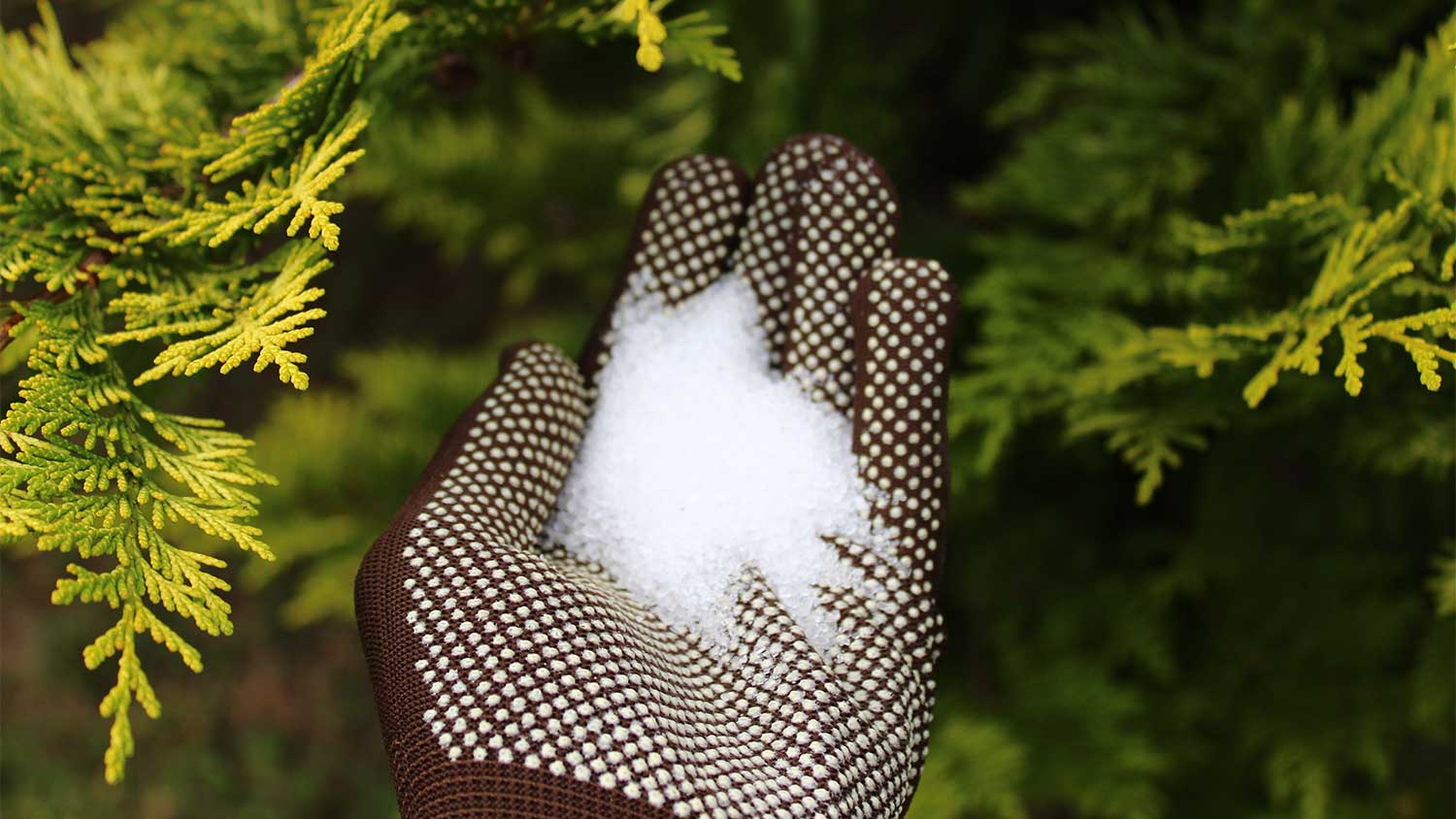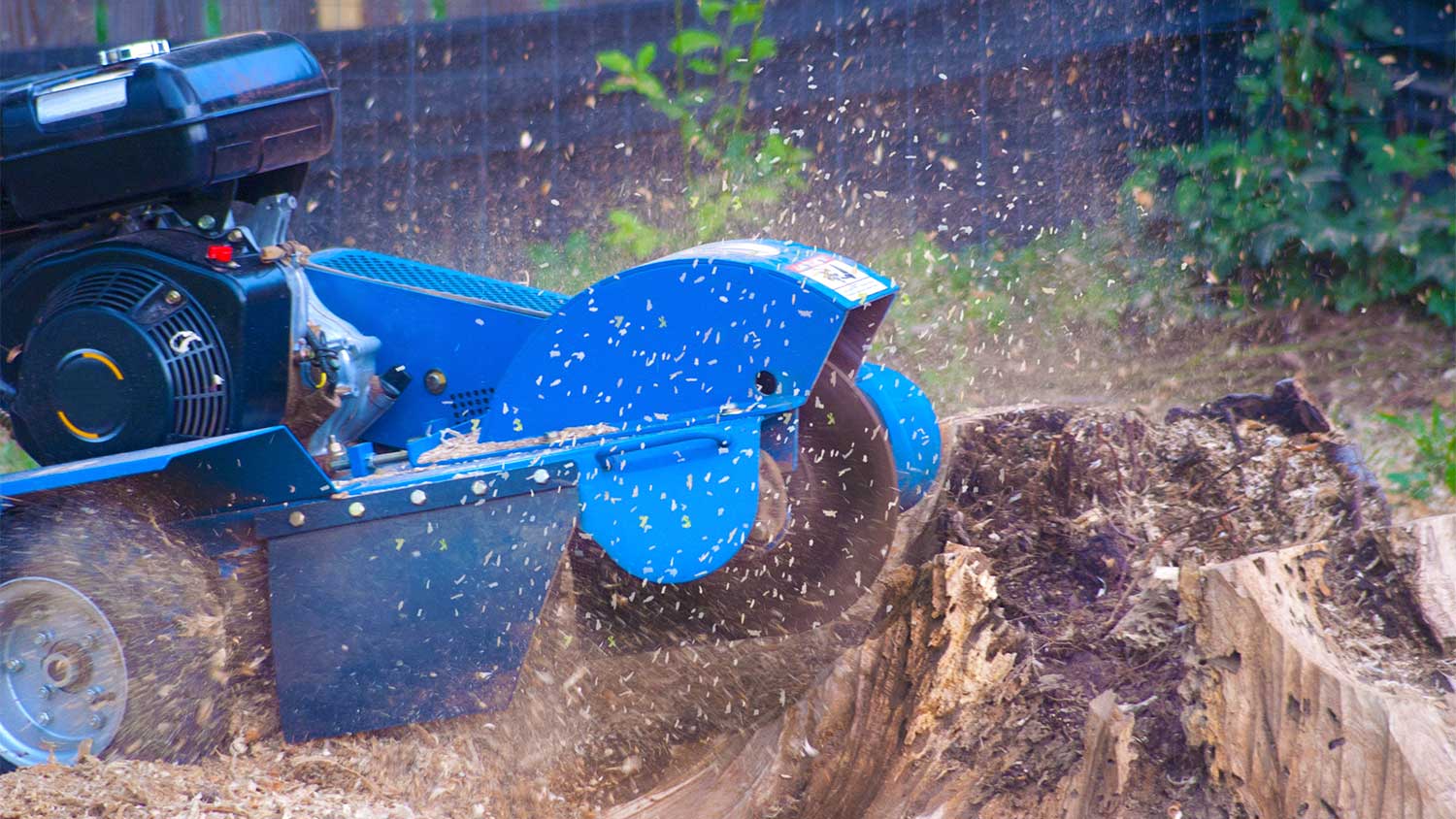
Find out how much it costs to plant a tree based on the number of trees, their size, where you want to plant them, and DIY versus professional costs.
It’s time for that stump to make like a tree and leave


From mighty oaks to delicate dogwoods, trees add an abundance of charm to your yard. But when a tree is dead, diseased, or simply a nuisance, you may need to consider removing it and learning how to kill a tree stump. From salt to chemicals to hiring a pro, learn the most effective DIY stump killer methods.


The salt method will take several months to kill the tree stump, but it’s inexpensive and fairly straightforward. It’s important to note that salt, especially rock salt, which has sodium and chlorine, can have adverse effects on any surrounding plants and lawn. Don’t use regular table salt.
For this method, in addition to salt, you’ll need a drill, 1/4 to 1-inch drill bits, a tarp, and a way to keep the tarp in place, such as rocks or stakes. If you don’t have a drill, you can use an ax or a chainsaw to remove the tree stump.
Buy salt: Purchase Epsom or rock salt from a grocery store, pharmacy, or hardware store.
Drill holes: Use a ¼-inch to 1-inch drill bit to drill a series of holes across the stump surface, 8–12 inches deep and 1 inch apart.
Add salt: Pack each hole with as much salt as it will hold.
Add water: Lightly water the stump to dissolve the salt.
Cover the stump: Use a tarp to cover the stump and stake it in place. Depriving it of light will help keep new shoots from forming. When the stump gives when you push or kick on it, it should be ready to dig up.

There are currently several products on the market designed to expedite tree stump decomposition. Some are glyphosate-based herbicides, and others are products with a high concentration of potassium nitrate.
These can be effective, though not necessarily more so than Epsom salt. They can still take months or longer to break the stump down enough to make it easy to dig out. Glyphosate products may also kill grass or surrounding plants, so use them with caution.
Follow the manufacturer’s instructions, wear protective gear, and keep pets and children out of the area. Grab a drill, 1/4 to 1-inch drill bits, a tarp, and heavy rocks or stakes to keep the tarp in place.
Choose your stump killer product: Find a stump removal product at your local home improvement store or garden center.
Drill holes in the stump: Using a 1/4 to 1-inch drill bit, drill holes across the surface of the stump about 1 inch apart. Drill a minimum of 8 inches deep or more.
Add the product: Fill the holes with the product—follow the package guidelines for specific instructions.
Cover the stump and wait: Deprive your stump of light by covering it with a tarp. Use stakes to hold it in place, as it can be several months before it’s ready for you to dig it out. Generally, if the stump wiggles when you push on it, you’ll know it’s ready to remove.

Light deprivation is one of the least expensive ways to kill a tree stump. You’ll expedite the decay and prevent new shoots from growing, as they won’t have sunlight. The only real cost is time. All you need is a tarp and a way to hold the tarp down.
Get a tarp: You can use a heavy-duty plastic bag, but the odds are it will start to break down before the stump does. A heavy-duty, dark-colored tarp is your best bet.
Cover the stump: Cover the stump completely with the tarp, making sure no light gets in.
Weigh the tarp down: Use tent stakes, rope and stakes, or even heavy stones.
Wait: Wait three to six months before checking the stump. After that, it should have decayed enough to dig up. A very large stump could take longer.

Another inexpensive method for expediting a tree stump’s demise is boiling water. All it costs is some sweat equity to expose the tree’s root system. The idea is to shock the tree by burning its root systems with scalding water.
Expose the roots: Dig around the stump to expose the root system. For smaller trees, you may need to dig very deep, but most larger trees will have roots within a few inches of the soil.
Drill holes: Across the top of the stump and all over the roots, drill as many holes as you can. Make them 1/4 to 1 inch in diameter and as deep as possible. On the stump, this can be 8 inches or deeper; the roots may only be an inch or two deep.
Boil water: Get the kettle on.
Scald the tree: Carefully pour boiling water on the root system and the top of the stump. Be sure to wear protective clothing and go slowly.
Wait: This method can kill the stump, but the decomposition process will still take several months. You’ll be able to dig the stump out easily once it moves when you push on it.

Grinding a stump involves the use of a stump grinder—a piece of equipment that is somewhat like a lawnmower with a big saw on the end of it. There are handheld models and large, ride-on versions.
The grinder literally grinds up the stump, leaving behind a pile of wood chips and a hole in the ground. A large stump can take four to eight hours to grind down.
If you plan to rent a stump grinder, verify that there are no underground utilities nearby. Damage to utility lines is expensive and can be dangerous. When operating a stump grinder, follow all safety guidelines, including wearing protective eyewear, earplugs, and work gloves.
Dig out the stump: Remove as much dirt as possible from around the stump base. Aim for a 2-foot wide trench around the stump that's at least 2 feet deep. Expose the stump’s roots and clear out any rocks.
Trim the stump: Using a chainsaw, remove any outstanding branches, trim the stump as low to the ground as possible, and cut off any connected roots. Stop when you're a few inches from the ground so that you don't experience the "kickback zone."
Rent your equipment: The cost to grind a stump varies, but, on average, a stump grinder rental will set you back between $190 to $270 per day from large hardware stores or small equipment rental shops.
Grind the stump: The stump grinding process will take a minimum of two hours and as long as eight, depending on the size of the stump.
Backfill: Once the stump grinding is done, you can remove some of the wood chips and add dirt or mix some of the wood chips in with the soil to fill in the hole.
Stump grinders are high-risk tools that can accidentally propel objects and debris. When using a stump grinder, equip yourself with protective gear and thoroughly clear the area. Alternatively, hire a professional stump grinder to ensure your personal safety and professional-level results.
Burning the stump is an effective way to rid it from your yard without having to rent a stump grinder. However, you should only take this task on yourself if you’re confident you can do it safely. It can be dangerous and is best left to a pro.
Check with your city and county laws to see if burning a stump is permitted. Some areas have burn bans and strict outdoor fire regulations. Avoid this work during times of drought.
Finally, wear gloves, goggles, and other protective equipment while burning a stump.
Trim the stump: With a chainsaw or handsaw, trim the stump to be as low to the ground as possible.
Drill holes: With a power screwdriver, drill 5/8-inch holes about 3 inches deep across the stump’s surface and into the sides of the stump. Place the holes approximately every 5 inches.
Fill the holes: Pour vegetable oil into the holes. Let it sit for 24 to 48 hours, then pour more vegetable oil into the holes.
Add charcoal bricks: Place enough charcoal bricks to cover the majority of the stump’s surface.
Light the charcoal: Let the stump burn out while you watch the fire at all times. Keep a fire extinguisher on hand in case of an emergency.
Backfill: Remove any remaining pieces of the stump and fill the hole with dirt.
Digging out a tree stump is highly recommended for small tree stump removal. However, it’s highly labor intensive, so hire a tree stump removal professional for best results.
Start two days before removal day by watering the soil around the stump. Wet the area enough to loosen the soil without creating mud.
Cut aerial and in-ground anchor roots. This step will weaken the stump's hold.
Then, use an ax, root saw, or loppers to cut through exposed roots.
Dig underneath the stump using a digging bar. You’ll need to lever the bar up and down and left to right to raise the stump from the ground.
Cut the newly exposed roots with an ax, root saw, loppers, or the chisel end of the digging bar. With a shovel, dig around the stump and uproot it.
Fill the hole with soil.
There are several chemicals and removal methods that you should not attempt to use to lift your tree stump for the ground. Here are a few to avoid:
Bleach: Pouring bleach on your tree stump will increase the pH level of the surrounding soil, damaging nearby plants and landscaping.
Weed killer: Weed-killing chemicals may effectively remove weeds from your yard, but it won’t make a dent in tree stump removal.
Diesel: Some people may consider adding diesel to a tree stump if burning it, but that method won’t create a lasting-enough burn to work.
Although it takes time, removing a stump will elevate your yard’s aesthetic. Here are some tips for successful stump removal.
Avoid bleach: The amount of bleach you’d need to decay the stump would kill all the surrounding plants.
Save your weed killer for weeds: Weed or grass killers will not kill your tree stump. They aren’t strong enough.
Think about other plants: Before you employ any method, check how close the stump is to other plants and if any of the methods have the potential to harm those plants or your grass. Tree stump removers that are made primarily of potassium nitrate will not hurt your grass.
Ask about stump removal: Tree removal does not always include stump removal. You can save time and money by having it all done at the same, so ask your tree removal specialist how much it’ll cost for both.
Use extreme caution when burning a stump: Burning a stump or using a chemical firestarter can be extremely dangerous and cause damage or injuries. Burning a stump might also be banned in your area. Check local laws and burn bans before starting, and consider letting a local tree removal service handle the tree stump burning.
Water your stump: You can water your stump every few days to help keep it moist and encourage the growth of fungi that will break it down even further.
You can kill a tree stump using a variety of methods, but some of the stump might still remain even after ample effort and hours of work. Stumps are incredibly difficult to get rid of, and it often makes sense to hire a local stump removal professional or landscaping company, especially if the stump is in a prominent location in your yard.
The cost of killing a tree stump can vary greatly depending on your chosen method. Epsom salt and chemical tree killers cost around $10. However, if you need to buy supplies or tools such as a shovel, drill, or chainsaw, your costs go up to $150 or more. Renting a stump grinder costs $190 to $270 per day, and grinding can take up to eight hours of work.
You can hire a landscaping company in your area if they offer this service or contact a tree removal company. If you’re hiring a pro, the average cost of stump removal ranges from $100 to $150.
From average costs to expert advice, get all the answers you need to get your job done.

Find out how much it costs to plant a tree based on the number of trees, their size, where you want to plant them, and DIY versus professional costs.
Get transparent shrub removal cost info. Learn average prices, key cost factors, and tips to save on your next shrub removal project.

Discover what the current average tree removal cost is based on different factors to know how much it will cost to take care of a dead or troublesome tree on your property.

Arborists define Dutch elm disease as one of the most destructive diseases a tree can catch. Here’s what you can do—from spotting symptoms to treatment.

Need to know how to kill a tree? If it’s disrupting your foundation or plumbing, learn how to kill the tree and its roots with these tips.

A dead or dying tree on your property usually calls for removal. Damaged or diseased trees may be fixable. Find out the signs your tree needs to be removed.